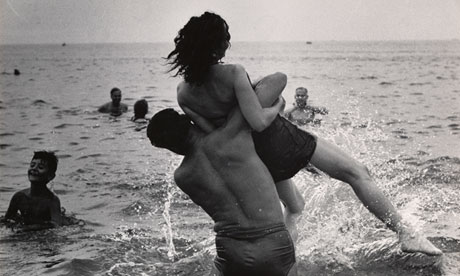To say that Garry Winogrand was productive is to dramatically understate the case. When he died in 1984, he left behind a huge archive: over 35,000 prints, 22,000 contact sheets and 45,000 colour transparencies. Perhaps more astounding still were the 6,500 rolls of unprocessed films, a testimony to a vocation that bordered on an obsession.
In the late 1960s and early 70s, Winogrand tramped the streets of New York daily, with several cameras hanging around his neck and a bag of film flung over his shoulder. The photographer Joel Meyerowitz, who often crossed paths with him, later said: "Garry set a tempo on the street so strong that it was impossible not to follow it. It was like jazz. You just had to get in the same groove." Winogrand himself said of his impetus: "When things move, I get interested."
His pictures reflect the momentum of the urban, post-second world war city in their skewed angles and odd compositions, which he often achieved by using a wide-angle lens tilted upwards while shooting literally from the hip. At first, people did not know what to make of his pictures (or those of his contemporaries, Meyerowitz and Lee Friedlander) and the term "snapshot aesthetic" was applied by critics still in thrall to the more measured compositions of Cartier-Bresson or Walker Evans, whose seminal book, American Photographs, was a huge formative influence on Winogrand. It was only when Winogrand was included in the New Documents exhibition at Moma in New York in 1967, alongside Friedlander and Diane Arbus, by the visionary curator, John Szarkowski, that the new raw and edgy sensibility they had created was recognised and defined.
Over 45 years later, this heavyweight book is the catalogue to a mammoth retrospective of Winogrand's work currently on show at Moma in San Francisco. It contains familiar images and others that have never been seen until now, edited and printed from those thousands of rolls of unprocessed films. The book shows that Winogrand was not just a street photographer, and that New York, though his favoured location, was not his only one. His photographs from Los Angeles are sometimes muted by Winogrand's standards, but they capture the tempo of the west coast as acutely as his New York or Chicago pictures reflect the bustle of those more combative eastern cities.
His friend Lee Friedlander once said of Winogrand: "He was a bull of a man and the world was his china shop." His photographs certainly have an energy and compositional flair that are all his own, and his shadow looms over street photography to this day. Often imitated, seldom bettered, he is one of the giants of postwar American photography and, excellent as this book is, we can only hope the accompanying exhibition will make it to these shores soon.











